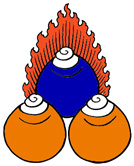"Not to be realized from another, peaceful,
Not elaborated by elaborations,
Not conceptualized, and not a separate entity,
That is the characteristic of ultimate reality."
Nâgârjuna : Mûlamamadhyamakakârika, 18:9.
"The Buddha said that all things have two natures.
Those found by perceivers of reality
and those found by perceivers of
falsity.
Objects of perceivers of reality are things as they are.
Objects of perceivers of falsity are conventional truths."
Candrakîrti : Madhyamakâvatâra, 6:23.
|
Relative to the adopted "established conclusion"
("siddhânta") or tenet, the Two Truths ("satyadvada"), the division between conventional
truth ("samvriti-satya") and ultimate truth ("paramârtha-satya"), can
be viewed (as in Platonism) as two
levels of reality (two types of truth) or as two objects of knowledge.
The former view comes close to abolishing the Two Truths, replacing
the division by the One Truth of the ultimate (negating conventional
truth as a whole). The latter maintains the division. This last
tenet is rightly considered superior.
|
In the Critical Mâdhamaka of Tsongkhapa, the
basis of the division is not two levels of reality, but two objects of
knowledge defined as the two epistemic isolates (or "natures") of a
single given phenomenon. Ultimate reality is not "higher" than conventional reality,
but merely a property of every possible phenomenon.
Every existing thing is an object of knowledge possessed by a subject or
object-possessor. But every existing thing has two natures : a
conventional one & an ultimate one. Conventional knowledge apprehends the
conventional nature of an object, ultimate knowledge prehends the
ultimate nature of the same object. When the conventional, deceptive
nature is apprehended, the ultimate, nondeceptive nature is excluded and
vice versa. Except in the mind of a Buddha, for whom the two truths
are simultaneous.
Although the division between these Two Truths is born out of the
yogic experience gathered during meditative equipoise, drawing the
division between the world as experienced by ordinary beings versus
the same world as witnessed by Superior Bodhisattvas and Buddhas, it also
points to the philosophical difference between, on the one hand, a
"relative" reality appearing otherwise as it is (i.e. a deceptive
conventional truth), and therefore deemed "illusionary", and, on the other
hand, reality-as-it-is, also called
"suchness", i.e. the nondeceptive, "absolute" reality
("dharmadhâtu").
The Two Truths are implied by the
Third Noble
Truth, the Truth of Cessation. Ordinary reality is unsatisfactory
(First Noble Truth of Suffering) and this suffering is caused by ignorant
craving (Second Noble Truth of Arising). The possibility of ending this
cycle of continuous suffering (sickness, old age, death, experiencing what
is not wanted and not experiencing what is wanted) was realized by the
Buddha when he awoke from the dream all sentient beings are still
dreaming. At this point, he saw the reality of things just as they are,
namely their ultimate nature or ultimate, absolute reality. Deciding to
remain in this world of conventional truths, the Buddha used the
conventions of "samsâra"
to point out the right direction : Cessation.
The doubleness of all things part of our world, the distinction between how things
appear and
how they truly are is recurrent in many, if not all, spiritual
systems. The basis question before us therefore is : What is truly real ?
Answering this in the context of the Buddhadharma implies study,
reflection & meditation. Nothing else will do. Without putting in the necessary effort
with great diligence, the question will never be answered and the truth-concealing
realities will not be eliminated. If so, cessation, the end of
unsatisfaction & suffering cannot be seen.
Explanations of the Two Truths are found in the assertions of each of the
four tenet systems on
emptiness
("śûnyatâ") exegetically developped by the Gelugpas, the religious order founded by
Tsongkhapa (1357 - 1419). Ranked from the highest, most profound to the
lowest, these systems are :
Great Vehicle systems :
1) Middle Way School or "Mâdhyamika", traditionally divided by
the Tibetans in two subsystems : the
Autonomy system ("Svâtantrika Mâdhyamika") and the Consequence system
("Prâsangika Mâdhyamika") ;
2) the Mind-Only School or "Cittamâtra" (also : Yogâcâra) ;
Lesser Vehicle systems :
3) the Sûtra School or "Sautrântika" ;
4) the Great Exposition School or "Vaibhâsika".
As various authors (Hopkins,
1983, Newland,
1999) have extensively & clearly explained the differences between these
tenets, nothing of the sort will be repeated here. Although often
considered as a single homogeneous system, radically different Mâdhyamika
views emerged, like those between idealist Sakya authors as Gorampa Sönam Sengé (1429 - 1489)
-so-called Yogâcâra Mâdhyamaka- and critical interpretations, like those of Tsongkhapa (Thakchoe,
2007). And according to the Jonang school, the Middle Way is crowned by
other-emptiness (not self-emptiness), affirming the inherently existing
enlightened qualities of our Buddha-nature. As will be shown, this last
tenet is experiential, not philosophical or logical (and so not a "tenet"
at all).
In Prâsangika-Mâdhyamaka, the highest tenet system, the difference
between the Two Truths is established on the basis of a single
ontological identity with distinct conceptual isolates. All things
have two natures or properties, those based on reality and those based on falsities (cf.
Chandrakîrti in his Mâdhyamakâvatâra). A sprout, insofar as it
conceals its lack of inherent existence, is a falsity. The same sprout,
insofar as its ultimate nature is known as lacking own-form, is true. Both
truths share the same ontological status, but their difference is based on
the object of knowledge. Conventional truth has the false nature of things as
object. Ultimate truth has the true nature of things as object. Although they share
the same ontological identity (the same sprout), their mode of appearance
differs : the conventional nature of the sprout is deceptive (appears
inconsistent with its true mode of existence), while its ultimate nature
is nondeceptive and appears as it is. The first is an illusion, the
second not.
The Two Truths point to these two natures, these different conceptual
objects designated on the basis of a single phenomenon. The same sprout
can be known as a conventional nature (deceptive) and as an
ultimate nature (nondeceptive). Although the Two Truths
presuppose a common, single phenomenon or entity as their common referent,
they are not merely epistemological or linguistic distinctions, for
ultimate truth has the ultimate nature of the sprout as object (namely
emptiness), while conventional truth has the conventional nature of the
same entity as object (namely illusionary own-form). Emptiness does not negate
conventionality, but substantial instantiation. The dual natures are
locked together within each phenomenon, and so constitute the same
phenomenon. Both truths possess the same ontological status, and are thus
grounded in the dual nature of every single phenomenon. The nondeceptive
nature of the empty phenomenon constitutes its ultimate truth.
For Chandrakîrti, Śântideva & Tsongkhapa, the Two Truths have the two
natures of each and every phenomenon as their ontological reference, and
so their distinction is not purely epistemological, but rooted in their
identical ontological status, and so ultimate truth is not higher than
conventional truth (as the idealists claim). Although verified along
different epistemic pathways, they have an equal ontological status and
soteriological value.
For Tsongkhapa, conventional truth is an object found by an empirically
valid cognition perceiving mistaken objects of knowledge and ultimate truth
is an object found by a reasoning consciousness perceiving reality as
it is, unmistaken. Although conventional truth is valid insofar as conventionality
is concerned, it represents its object in a deceptive way and is therefore
false. While this object is in reality not substantially instantiated,
conventional truth represents it as such. So in this view, invalid
conventional knowledge remains possible, while for the idealists all
conventional realities are deceptive and so false or invalid, blurring the
possibility of establishing conventional distinctions between valid &
invalid conventional knowledge. If per definition conventionality is
invalid, then compassionate action can never be valid. This is
unacceptable.
Ultimate truth does not
misrepresent its object, does not conceal the truth of its object, but
sees it as it is (suchness). For Tsongkhapa, empirical truths are not
posited by ignorance. His object of negation is not conventionality as
such, but the substantial instantiation of phenonema, or, which is the
same, not knowing phenomena as dependently arisen, but as independent,
self-powered, independent phenomena with own-power ("svabhâva").




